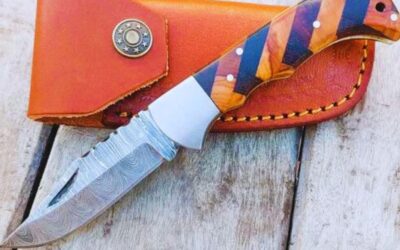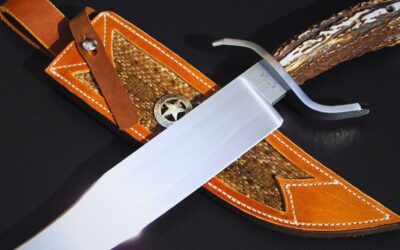Using a knife sharpener can seem scary. But don’t worry! This guide will show you the way. We’ll ensure your blades are sharp as razors and all set!
Why is it so important to keep knives sharp?
Dull knives slow down your work in the kitchen. Plus, they can be dangerous. When a knife isn’t sharp, it needs more force to cut. That increases the chance of accidents. So, it’s essential to keep blades sharp for precise and easy cutting.
You need the right tool to sharpen a knife. Honing rods, whetstones, and electric sharpeners are all options. Pick the one that suits your skill level and convenience.
To sharpen, hold the handle of the knife firmly with one hand. Place it at an angle of 20-30 degrees against the sharpener a knife. With light pressure, slide the blade back and forth over the coarse side. Do this until you have a clean edge on both sides.
Next, switch to the fine side of the sharpener. Use the same motions, but less pressure. This further refines and hones the edge.
Consistency is key. Keep the angle steady and apply equal pressure on both sides of the blade. Take breaks if needed, so you don’t overheat.
Wash and wipe off any residue before testing sharpness. A sharp knife should glide through paper or a tomato without squashing it. If you need to improve any areas, repeat the sharpening process.
Now that you know how to use a knife sharpener, don’t let your knives get dull again! Make regular sharpening sessions part of your kitchen routine. Enjoy the satisfaction of effortless cutting and never fear dullness! Let’s sharpen!
Understanding the Different Types of Knife Sharpeners
Knife sharpeners come in various types. Let’s look at the key features of some popular ones:
- Whetstones: Need water or oil for lubrication.
- Sharpening Steels: Rod-shaped tool, straighten and align knife blades.
- Electric Sharpeners: Motorized device with built-in guides.
- Pull-Through Sharpeners: Simple handheld tools with a slot.
Plus, diamond-coated sharpeners and honing rods provide extra durability and efficiency.
An interesting story: A chef had trouble with dull knives until he got an electric sharpener. He was amazed by how fast and easy it sharpened his blades. From then on, his cooking improved significantly!
Armed with this knowledge about knife sharpeners, you can now choose wisely. Whether you go traditional with a whetstone or electric, keeping your knives sharp will boost your culinary skills.
How to Choose the Best Knife Sharpener for Your Needs
Selecting the right knife sharpener is essential for great outcomes. Here’s a summary of the different types to help you make an educated decision.
| Manual Knife Sharpener | Electric Knife Sharpener | Whetstone | |
|---|---|---|---|
| Sharpness Level | Moderate | High | Customizable |
| Ease of Use | Requires Manual Effort | Effortless | Requires Skill |
| Versatility | Compatible with Most Types of Knives | Limited | Compatible with Most Types of Knives |
| Durability | Long-lasting | Durable | Requires Regular Maintenance |
Moreover, manual knife sharpeners are more budget-friendly and portable compared to electric ones. On the flip side, electric knife sharpeners are efficient and suitable for individuals with limited time or strength.
To get the most out of your knife sharpener, think of these:
- Appropriate angle: Keep a consistent angle during sharpening for the desired effect. A good angle is between 15 to 20 degrees.
- Stick to maker instructions: Every sharpener has precise directions for usage and upkeep. Make sure to study and abide by them for ideal performance.
- Frequent cleaning: Keep your sharpener clean by getting rid of any metal shavings or residue that may build up over time. This will stop clogging and guarantee effective sharpening.
By taking these tips into account, you can pick a suitable knife sharpener depending on your needs and maintain its performance in the long run.
Preparing Your Knife for Sharpening
Properly preparing your knife is essential for optimal sharpening results. Follow these four simple steps to get your knife ready:
- Clean the blade. Remove any dirt, grime or food particles. This helps get better results and prevents damage to the sharpener.
- Check for damages. Look for chips or nicks. In the event that you see as any, have it fixed by an expert.
- Secure the knife. Use a clamp or hold the handle firmly while placing your other hand on top of the blade.
- Protect your hands. Wear cut-resistant gloves or place a towel underneath the blade.
In addition, select the right type of sharpener and take note of the angle to achieve desired sharpness. Use lubrication like honing oil or water to reduce friction. Apply light pressure while sharpening; avoid excessive pressure.
By following these steps, you can prepare your knife for sharpening, ensuring superior results and a safe process.
Step-by-Step Guide to Using a Knife Sharpener
Mastering the art of sharpening knives may seem intimidating, but it’s really simple! Just follow a few easy steps to keep your blades sharp and efficient.
- Begin by securing the sharpener on a stable surface.
- Hold the knife firmly in one hand and place the blade against the coarse side of the sharpener, maintaining a 20 degree angle.
- With gentle yet firm pressure, draw the knife along the length of the sharpener alternating between sides.
- Then switch to the fine side to refine and polish the blade.
- Repeat the process.
With training, you’ll foster a method that turns out best for you. Make a habit of sharpening your knives every few weeks or as needed to keep them cutting edge and prolong their lifespan.
Take control of your kitchen tools and enjoy effortlessly slicing through ingredients with razor-sharp precision! Start using a knife sharpener today!
Tips for Maintaining and Caring for Your Knife Sharpener
Maintaining and caring for your a knife sharpener is key for optimal performance and long life. Here’s how to keep it in great shape:
- Clean up: After each use, wipe away any debris or shavings with a damp cloth or brush.
- Storage: Keep the sharpener in a dry and safe place, free from moisture and extreme temperatures.
- Sharpening method: Follow the manufacturer’s guidelines for the best results.
- Inspect: Check for wear and tear – replace or repair any damaged parts.
- Maintenance plan: Create a plan based on use frequency and follow it.
More tips for keeping it in tip-top condition:
- Don’t use too much pressure while sharpening.
- Use lubricants recommended by the manufacturer.
- Cover the sharpening stones with a protective cover when not in use.
Did you know? With proper maintenance, your knife sharpener can last up to 10 years!
Put these tips into practice and you’ll never have dull knives again.
Conclusion
Knife sharpeners can be a great way of improving your cooking. Regular sharpening not only increases the life span of your knives, but they also let you cut more safely and effectively. Make sure to get the right sharpener for your needs, either manual or electric. Follow the manufacturer’s instructions to get the best results.
When sharpening, you must hold the blade at the right angle. Keep a steady motion when using a sharpening stone or honing rod to get a sharp edge. After sharpening, clean and dry the knives to avoid rust.
In addition to sharpening, be careful when using knives. Store them in a holder or sheath to prevent accidents. Don’t force a dull knife; sharpen it regularly instead.
A professional chef once said his cooking skills improved after mastering knife sharpening. His chopped ingredients were perfectly presented, and the flavors were evenly distributed. With the right knife sharpener, he was able to make unforgettable dishes.
To summarize, use a knife sharpener to enhance your cooking. Take care of your knives with regular sharpening and safe handling practices. Use this tool to bring out the best flavors in every meal!
Frequently Asked Questions
1. How often should I sharpen my knives?
It is recommended to sharpen your knives regularly, especially if you use them frequently. As a general guideline, sharpening them every 2-4 months should keep them in optimal condition.
2. How do I choose the right knife sharpener for my needs?
The right knife sharpener depends on your specific needs and preferences. There are different types of sharpeners available, such as manual sharpening stones, electric sharpeners, and honing rods. Consider factors like ease of use, sharpening speed, and knife types supported before making a decision.
3. Can I use a knife sharpener for serrated knives?
Not all sharpeners are suitable for serrated knives. If you have serrated knives, it’s important to choose a sharpener specifically designed for them, such as a serrated knife sharpener or a multi-sharpener that supports serrated edges.
4. Is it possible to damage my knives while sharpening?
Yes, it is possible to damage your knives if not done properly. To avoid this, follow the instructions provided with your sharpener carefully. Ensure you maintain the correct sharpening angle, use appropriate pressure, and take your time to achieve the desired result.
5. Are there any safety precautions I should take when using a knife sharpener?
Absolutely! Here are some safety precautions to follow when using a knife sharpener:
- Read and understand the user manual before usage.
- Use protective gloves to minimize the risk of injuries.
- Secure the sharpener properly on a stable surface.
- Get your hands far from the edge during honing.
6. Can I sharpen other tools besides kitchen knives?
While knife sharpeners are primarily designed for kitchen knives, some models can also be used for sharpening other tools like scissors, pocket knives, and hunting knives. Always check the sharpener’s compatibility and guidelines to ensure safe and effective sharpening.




0 Comments